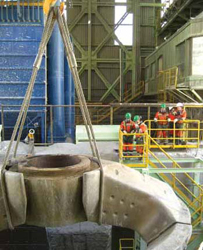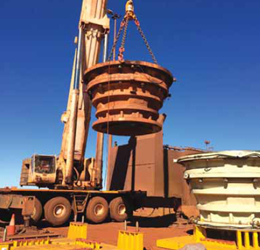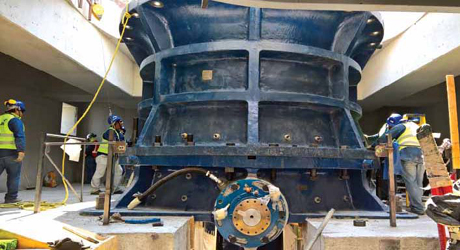
Safety is paramount when working on such large, heavy
pieces of equipment. (Photo: Metso Outotec)
TLC for Primary Crushers
A gyratory crusher is a significant investment for any mine.
Take care of it and it will serve you well.
By Carly Leonida, European

Preventative Maintenance
Assuming the correct gyratory model has
been selected for the job, let’s start with
preventative maintenance, because prevention
is always better (and less costly)
than the cure.
The team at FLSmidth has been working
with a number of customers recently to
eliminate unexpected crusher shutdowns
and to optimize equipment reliability. Manager
of Life Cycle Services Charlie Madsen
was happy to share this knowledge.
“Planned major maintenance predominantly
means liner changeouts,” he said.
“But generally, the crusher will be shut
down for two mantle changes and one
concave change per year. Mantle changes
can be done in approximately 24 hours
and a concave with a mantle change in
four to seven days depending on factors
such as mine location and site specifics.
“Hydroset replacements are planned/ recommended anywhere between one and five years, again depending on site-related variations. General maintenance is hard to time, but an educated estimate would be something along the lines of three to four days every half year. Maintenance schedules are planned through information, data, and trending of wear and components.” Rate of wear and wear characteristics are typically determined by the orebody type, work index, abrasiveness and fracture rate, as well as throughput. “These are characteristics that can change over the lifespan of a pit or orebody, requiring constant attention to liner material choice and profiles. This ensures wear patterns and wear loss are kept at the optimum level and secures lowest cost per metric ton in operation,” Madsen said. “FLSmidth mitigates wear rates by using different types of manganese in its liners, upgrading to chrome-moly where necessary. White iron can also be advantageous.”
Combining this with the optimization of liner profiles, throat/chamber design and operations on-site for feed characteristics tends to give the most successful result, and changes in the above can extend liner profiles and throughput over a lifetime by up to 500,000 mt in some cases. This is obviously welcomed by the customer as downtime is cut and maintenance costs reduced. Madsen explained: “There are an abundance of checks that should be carried out fully and thoroughly in preventative maintenance inspections and with a computerized maintenance management system (CMMS). These, in combination with customer training, can reduce maintenance times and cut unplanned failures. It also enables more consistent scheduling of work activities, planned shutdowns and parts supply.”
Maintaining the open side setting (OSS) is typically done by operators with a control system that shows the main shaft position at all times. FLSmidth’s automation team has designed new software that can carry out optimization of the main shaft position based upon a number of instruments that maximize throughput, power/wear and final product. “Calibration of the main shaft is an infi eld exercise, as manual verification and measurements have to be conducted in order to calibrate and scale the electronic equipment,” said Madsen. “By optimizing the main shaft position, we create a more effective and constant wear profile, which allows the end user to get full wear out of liners.”
FLSmidth is in the early stages of developing a comprehensive maintenance management system for its Excel-Raptor cone and gyratory crusher lines. “We also we have a self-aligning main shaft, which improves on installation times, and more importantly, safety and suspended loads,” Madsen added. “We are also the only OEM with a fully top service gyratory, which improves on maintenance downtime and saves on building and construction designs and sizes.” The team has designed routable shell segments to reduce concave liner changeout times, and its spider removal jacks have also been redesigned to increase their size. These are threaded into the shell rather than being free standing to reduce manual handling requirements and improve ergonomic positioning for staff.
Upgrades and Overhauls
Of course, there will come a time when
certain parts need to be upgraded to
take advantage of new designs and
safety features, or overhauled to maintain
their performance.
“Really, any time can be a good time
to upgrade a crusher,” Lucas Steiner,
director of mining crusher products at
Metso Outotec, told E&MJ. “Key things that
customers should be looking for are: have
their operations changed over time? Are
there any performance issues that could be
improved upon? Or are they anticipating a
change in the future and need to start positioning
themselves to avoid lost production?

Major repairs or upgrades usually require a shutdown and this takes signifi- cant planning — sometimes upward of a year — to have the materials brought to site and the right teams assembled to ensure Formula 1 pitstop style efficiency. This has meant that, despite the challenges of COVID-19 impacting mines across the globe, many have proceeded with the maintenance shutdowns they had planned; these kinds of activities are not easy to reschedule.
Steiner explained: “Upgrades can vary greatly in scope depending on what the customer wants to accomplish. Simpler upgrades might involve replacing just a few parts or an entire assembly. For example, in our portfolio, we have a shimmable manganese spider bushing. It’s a direct drop-in to a current bushing spot, but it can bring up to three times the life. That’s a simple upgrade, which would require very little planning. The parts can be positioned and readied while the machine is operating and implemented during a standard one to two-day shutdown period. “On the other hand, a speed upgrade, which would allow the mine to get more tonnage out of their machine is far more complex. That might include lube changes, drive motors changes, drive system changes and possibly other internal components too. We can still ready the parts during operations, but it would require more planning and perhaps a three to fourday shutdown.”
Thorough planning is key to minimizing shutdown times. “The best way to implement upgrades and minimize disruption to operations is to get our personnel involved from the start,” Steiner said. “If we build a good plan of how the activities should flow, get the proper parts ready… then shutdown times can be minimized. Customers can capitalize on Metso Outotec’s knowledge and resources, whether that’s physical labor or just advisory staff. “We can help to preassemble components, reposition things and develop a timeline for implementation. And then we can help to tweak performance after an upgrade is implemented with process optimization. It’s really dependent on what the customer wants, what their capabilities are and what they need help with.” Given the wide-ranging nature of upgrade activities, E&MJ asked: what separates everyday maintenance jobs from “upgrades?”
“When we look at upgrades, we’re looking at things that make maintenance easier, make the machine more reliable or get more production out of the machine,” explained Steiner. “Upgrades usually involve operational parts of the machine versus the wears parts. Replacing wear parts or adding custom liners would be more of an everyday maintenance activity.”
Safety and Efficiency
Metso Outotec recently released a new
rotable top shell for its Superior gyratory
line and has formalized its upgrade and
overhaul offering into a comprehensive
program called MK nXt.
The Superior gyratory line was introduced
in 1953 and, since then, the design
has gone through several iterations, with
each successive MK release incorporating
design improvements to boost production
and safety. The latest version, the MKIII gyratory
was released in 2019, and that was
when the former Metso decided to aggregate
its upgrade offerings into a solution.
Steiner explained: “Every time a new
MK number was launched, we had customers
with an older version asking how
they could modernize their machine. So,
we decided to create a solution that pinpoints
what upgrades the customer could
actually benefit from rather than doing a
blanket upgrade on everything.
“The MK nXt program breaks down available upgrades into three main categories: production, reliability and maintenance. The customer can use those categories to see which upgrades could best help them to meet their business goals; it gives them the best return on investment.” Currently, Metso Outotec doesn’t have a similar program in place for its other crusher lines, but that may change if MK nXt proves to be a success. So far, the indicators are good. The team has performed spider upgrades and speed upgrades for mines in North America and Australia. “We’ve applied our manganese shimmable spider bushing multiple times at sites around the globe to help customers looking for reliability enhancements,” said Steiner proudly. “We’ve also implemented rotable shell change-outs to improve maintenance efficiencies in Australia. And we have multiple opportunities for that on the horizon throughout North America, too.”

“We looked at that and said ‘okay, why don’t we do the same thing we do with cone crushers and change out the whole shell in one lift,’” said Steiner. “We’ve provided means to more easily install and remove that shell. We’ve made provision so that the concaves can be installed in the shells with them removed. We can actually take the existing top shells from the machine and convert them to be used in a rotable program.” As part of the new solution, Metso Outotec offers OEM liners with custom optimization of the wear profile for both production and wear life, installation support, shutdown labor, and a multitude of different life cycle service options.
“We’ve also worked with customers looking at flexible financing programs and packages,” Steiner said. “To go to a rotable shell concept can be quite pricey because it involves some very large pieces. But we’ve been able to, in quite a few cases, turn what would typically be a CAPEX requirement and bring it into OPEX budgets.” Faster, safer change-outs mean that extra time can be spent on other tasks during shutdowns. Steiner explained: “Say, in the past it took you two days to do a concave changeout… If you get that down to one day, now you have an extra day to do other maintenance or you can get back to operating. It takes less manpower so you can have leaner maintenance crews. Or, if you have the same number of people, you can apply them to other maintenance projects.
“Then there’s the safety aspect; the shells with used wear parts can be stripped down and realigned in a controlled environment. They can be moved away from the machine and worked on in a shop environment during off-peak times and while the equipment is running. “They can be inspected and repaired properly, versus being repaired in the field under a high-stress timeline. There are some shells that never get repaired properly because the timeframe is too tight. They just get patched back into the machine to get it back up and operating.”
Four customers already have the rotable top shell in operation and Steiner said there has been strong interest across the board. Currently, it’s only applicable to Superior gyratory models but Steiner hinted that retrofits for other gyratories might be in the pipeline, too.
Education and Training
When selecting a crusher, it’s worth
choosing an OEM that will not only assist
your team with maintenance planning
and execution, but one that can also provide
a holistic management program for
the entire life of machine. All three of the
companies interviewed for this feature do
so, and there are many more.
Times are changing and, in light of
COVID-19, automation and remote optimization
and training tools are proving
their worth many times over.
Mikael Lindberg, product manager
for services and performance agreements
in Sandvik Mining & Rock Technology’s
stationary crushing and screening line,
spoke to E&MJ about this trend.

“We want to make sure that the customer can handle the machine in the best way possible with the current staff that they have. If a machine is down, that’s bad for our brand as well as for the customer.” Proactive services are a crucial part of this. Like many OEMs, Sandvik offers periodic inspections where its personnel come out to site to train and teach staff. “That expert takes the whole staff through a practical training session, explaining what they need to look for in order to be proactive and predictive in their maintenance,” said Lindberg. “We have a digital service platform that allows us to collect performance data and fill in any gaps with information that the automation system cannot collect. We can then use that information to visualize different trends and provide statistics for users to help them understand if something is heading in a destructive direction or if there is an unhealthy pattern in machine performance. These inspections are important in detecting issues that a customer might not otherwise notice.
“You can’t just give customers a book and tell them to read it and trust what it says inside. Effective learning requires 10% classroom-based training, then 20% learning by doing with an expert to guide you, then 70% procedure. We try to work with that model.” For specific training sessions, Sandvik also uses augmented and virtual reality technologies to support learning, and Lindberg hinted that the company is developing a new digital tool or “ecosystem” for service interaction.
Automate and Optimize Optimization technologies are the final piece of the puzzle. Combining automation and artificial intelligence with the correct sensors and hydraulic controls allows operators to adjust power and crusher settings remotely and on-the-fly according to changes in feed characteristics, and even predict the need for alterations in advance. Digital twins are growing ever popular in this respect. Technologies such as these can be a huge help in predicting and preventing unplanned downtime.
“It’s also important to understand that you need to optimize a primary crusher in tandem with the downstream crushing and screening circuit to create system efficiency,” said Lindberg. “It’s not just about uptime on the gyratory. You need to look at the different system requirements and how you can put the system together to maximize efficiency, and make sure you hit your production targets or you will end up with bottlenecks.” It’s true; anyone can put together a plant that will operate, but to maximize efficiency and throughput requires experience.
“You can easily find a 20% productivity improvement just by looking outside of the gyratory performance and taking a systems approach,” added Lindberg. “If the primary, secondary and tertiary crushers and screens in between are not talking, then you will build silos and easily lose 20%-30% efficiency. “When we make a process audit, we can usually find at least a 5% improvement in efficiency, no matter where we go. That is why we try to include these in our productivity services. We want to create a continuous way of thinking with the customer, to balance their expertise with ours, and to tackle challenges and find solutions together.”